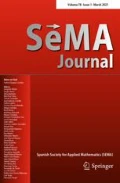Poya, Roman; Ortigosa, Rogelio; Gil, Antonio J.; Kim, Theodore; Bonet, Javier Generalised tangent stabilised nonlinear elasticity: A powerful framework for controlling material and geometric instabilities Journal Article In: International Journal for Numerical Methods in Engineering, vol. 436, 2025. Abstract | BibTeX | Tags: Hyperelasticity, Modeling and Simulation, PID2022-141957OA-C22 | Links: Ortigosa, Rogelio; Martínez-Frutos, Jesús; Mora-Corral, Carlos; Pedregal, Pablo; Periago, Francisco Mathematical modeling, analysis and control in soft robotics: a survey Journal Article In: SeMA, 2023, ISSN: 2281-7875. Abstract | BibTeX | Tags: Applied Mathematics, Control and Optimization, DICOPMA, Modeling and Simulation, Numerical Analysis | Links: 2025

@article{Poya2024,
title = {Generalised tangent stabilised nonlinear elasticity: A powerful framework for controlling material and geometric instabilities},
author = {Roman Poya and Rogelio Ortigosa and Antonio J. Gil and Theodore Kim and Javier Bonet},
doi = {https://doi.org/10.1016/j.cma.2024.117701},
year = {2025},
date = {2025-03-01},
urldate = {2025-03-01},
journal = {International Journal for Numerical Methods in Engineering},
volume = {436},
abstract = {Tangent stabilised large strain isotropic elasticity was recently proposed by Poya et al. (2023) wherein by working directly with principal stretches the entire eigenstructure of constitutive and geometric/initial stiffness terms were found in closed-form, giving fresh insights into exact convexity conditions of highly non-convex functions in discrete settings. Consequently, owing to these newly found tangent eigenvalues an analytic tangent stabilisation was proposed (for common non-convex strain energies that exhibit material and/or geometric instabilities) bypassing incumbent numerical approaches routinely used in nonlinear finite element analysis. This formulation appears to be extremely robust for quasi-static simulation of complex deformations even with no load increments and time stepping while still capturing instabilities (similar to dynamic analysis) automatically in ways that are infeasible for path-following techniques in practice. In this work, we generalise the notion of tangent stabilised elasticity to virtually all known invariant formulations of nonlinear elasticity. We show that, closed-form eigen-decomposition of tangents is easily available irrespective of invariant formulation or integrity basis. In particular, we work out closed-form tangent eigensystems for isotropic Total Lagrangian deformation gradient ()-based and right Cauchy–Green ()-based as well as Updated Lagrangian left Cauchy–Green ()-based formulations and present their exact convexity conditions postulated in terms of their corresponding tangent and geometric stiffness eigenvalues. In addition, we introduce the notion of geometrically stabilised polyconvex large strain elasticity for models that are materially stable but exhibit geometric instabilities for whom we construct their geometric stiffness in a spectrally-decomposed form analytically. We further extend this framework to the case of transverse isotropy where once again, closed-form tangent eigensystems are found for common transversely isotropic invariants. In this context, we augment the recent work on mixed variational formulations in principal stretches for deformable and rigid bodies, by presenting a mixed variational formulation for models with arbitrarily directed inextensible fibres. Since, tangent stabilisation unleashes an unparallelled capability for extreme deformations new numerical techniques are required to guarantee element-inversion-safe analysis. To this end, we propose a discretisation-aware load-stepping together with a line search scheme for a robust industry-grade implementation of tangent stabilised elasticity over general polyhedral meshes. Extensive comparisons with path-following techniques provide conclusive evidence that utilising tangent stabilised elasticity can offer both faster and automated results.},
keywords = {Hyperelasticity, Modeling and Simulation, PID2022-141957OA-C22},
pubstate = {published},
tppubtype = {article}
}
2023

@article{Ortigosa-Martínez2023,
title = {Mathematical modeling, analysis and control in soft robotics: a survey},
author = {Rogelio Ortigosa and Jesús Martínez-Frutos and Carlos Mora-Corral and Pablo Pedregal and Francisco Periago},
doi = {10.1007/s40324-023-00334-4},
issn = {2281-7875},
year = {2023},
date = {2023-08-04},
urldate = {2023-08-04},
journal = {SeMA},
publisher = {Springer Science and Business Media LLC},
abstract = {<jats:title>Abstract</jats:title><jats:p>This paper reviews some recent advances in mathematical modeling, analysis and control, both from the theoretical and numerical viewpoints, in the emergent field of soft robotics. The presentation is not focused on specific prototypes of soft robots, but in a more general description of soft smart materials. The goal is to provide a unified and rigorous mathematical approach to open-loop control strategies for soft materials that hopefully might lay the seeds for future research in this field.</jats:p>},
keywords = {Applied Mathematics, Control and Optimization, DICOPMA, Modeling and Simulation, Numerical Analysis},
pubstate = {published},
tppubtype = {article}
}









